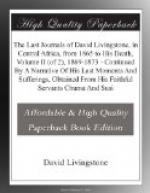Here is a well-authenticated instance which goes far to prove the truth of an assertion made to travellers in many parts of Africa. The natives protest that one species of snake will deliberately chase and overtake his victim with lightning speed, and so dreadfully dangerous is it, both from the activity of its poison and its vicious propensities, that it is perilous to approach its quarters. Most singular to relate, an Arab came to some of the men after their arrival at Zanzibar and told them that he had just come by the Unyanyembe road, and that, whilst passing the identical spot where this disaster occurred, one of the men was attacked by the same snake, with precisely the same results; in fact, when looking for a place in which to bury him they saw the grave of Losi, and the two lie side by side.
Natal colonists will probably recognise the Mamba in this snake; it is much to be desired that specimens should be procured for purposes of comparison. In Southern Africa so great is the dread it inspires that the Kaffirs will break up a Kraal and forsake the place if a Mamba takes up his quarters in the vicinity, and, from what we have seen above, with no undue caution.
Susi, to whom this snake is known in the Shupanga tongue as “Bubu,” describes it as about twelve feet long, dark in colour, of a dirty blue under the belly, with red markings like the wattles of a cock on the head. The Arabs go so far as to say that it is known to oppose the passage of a caravan at times. Twisting its tail round a branch, it will strike one man after another in the head with fatal certainty. Their remedy is to fill a pot with boiling water, which is put on the head and carried under the tree! The snake dashes his head into this and is killed—the story is given for what it is worth.
It would seem that at Ujiji the natives, as in other places, cannot bear to have snakes killed. The “Chatu,” a species of python, is common, and, from being highly favoured, becomes so tame as to enter houses at night. A little meal is placed on the stool, which the uncanny visitor laps up, and then takes its departure—the men significantly say they never saw it with their own eyes. Another species utters a cry, much like the crowing of a young cock; this is well authenticated. Yet another black variety has a spine like a blackthorn at the end of the tail, and its bite is extremely deadly.
At the same time it must be added that, considering the enormous number of reptiles in Africa, it rarely occurs that anyone is bitten, and a few months’ residence suffices to dispel the dread which most travellers feel at the outset.
February, 1874.—No further incident occurred worthy of special notice. At last the coast town of Bagamoio came in sight, and before many hours were over, one of Her Majesty’s cruisers conveyed the Acting Consul, Captain Prideaux, from Zanzibar to the spot which the cortege had reached. Arrangements were quickly made for transporting the remains of Dr. Livingstone to the Island some thirty miles distant, and then it became perhaps rather too painfully plain to the men that their task was finished.




